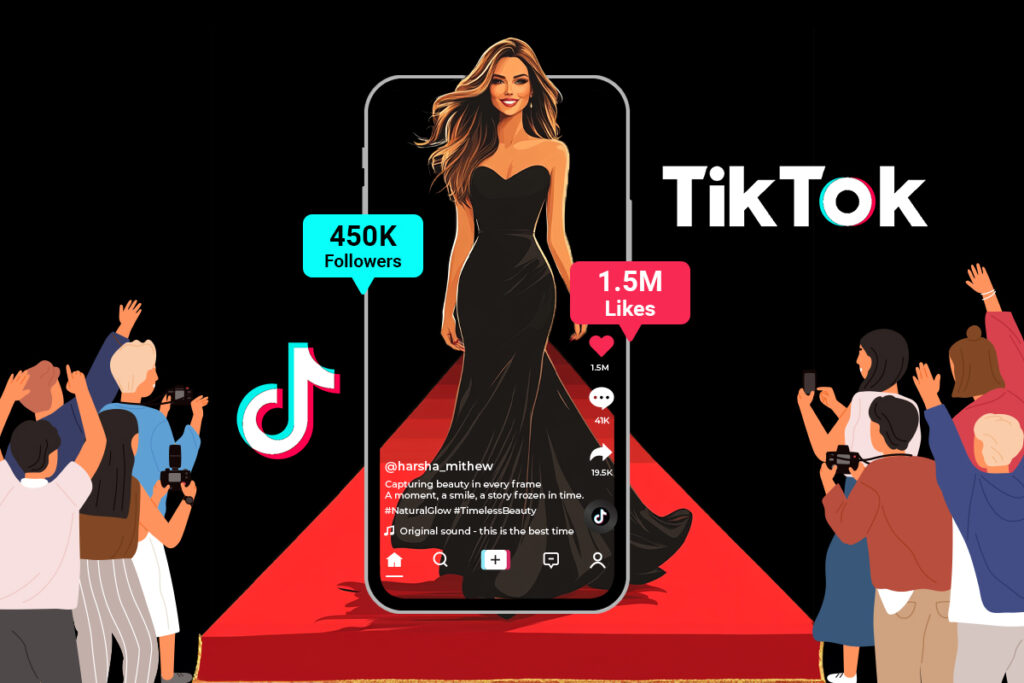To effectively benchmark TikTok metrics against competitors, start by identifying key competitors through strategic keyword and hashtag analysis. Leverage analytics tools like Keyhole to monitor engagement rates, where the average is 3.30%. Evaluate content strategies by examining diverse content types and trending hashtags, noting that successful brands often use four hashtags per video. Analyze posting frequency; top brands post 21 times monthly. Keeping a close watch on trending topics via TikTok’s Discover page can further refine your competitive strategy. These methods guarantee a thorough evaluation, enabling the identification of more effective content strategies and engagement techniques.
Key Takeaways
- Utilize analytics tools like Keyhole and Metricool for competitor performance metrics and benchmarking.
- Monitor competitors’ posting frequency and content types to align with industry standards.
- Analyze engagement metrics including likes, comments, and view rates for comparative insights.
- Track trending topics and hashtags to enhance content strategies and audience engagement.
- Evaluate high-performing competitor content to tailor your strategies to audience preferences.
Identify Key Competitors
In the landscape of TikTok marketing, identifying key competitors is an essential step for benchmarking and strategic planning. The initial phase involves searching for relevant keywords, hashtags, and trends associated with your brand or industry. This approach helps to identify accounts with a substantial TikTok presence that produce similar content. Compiling a list of 3-5 main competitors with comparable follower counts and engagement rates guarantees a relevant benchmark for performance analysis.
Utilizing TikTok’s discovery features, such as the “For You” page, can further uncover competitors that may not appear in direct searches but have a significant niche presence. This method enhances the competitor analysis by broadening the scope beyond obvious industry players.
Analytics tools like Keyhole and Metricool play an essential role in gaining insights into competitor performance metrics, including engagement rates and follower growth. These tools aid in identifying who to benchmark against by providing a data-driven perspective.
Monitoring competitors’ posting frequency and content types reveals industry standards and successful strategies. Understanding these elements allows for the adaptation of effective tactics to enhance your TikTok metrics, guaranteeing that your content remains competitive and aligned with market trends.
Analyze Engagement Metrics
Understanding engagement metrics is essential for evaluating the success of TikTok marketing strategies. As the average engagement rate on TikTok declines to 3.30%, benchmarking against competitors becomes important. Smaller profiles, with fewer than 5K followers, maintain a higher engagement rate of approximately 3.95%, suggesting that size-specific benchmarking can yield more accurate insights. In contrast, larger profiles with over 100K followers experience engagement rates up to 5.35%, emphasizing the role of audience trust.
Engagement metrics such as views per follower are significant for evaluating content effectiveness. Smaller profiles achieve a median view rate of 22.45%, which serves as a benchmark for assessing visibility and reach.
Similarly, likes are indicative of immediate content appeal, with smaller profiles averaging a like rate of 4.15%, which peaks at 5.25% for those with 10-50K followers. Tracking likes in comparison to competitors can highlight areas for improvement.
Comments offer another dimension of engagement. While smaller profiles can enhance their 0.70% comment rate through strategic captioning, larger profiles face a decline to 0.30%.
Utilizing TikTok Analytics to monitor these metrics allows brands to refine strategies and improve content effectiveness.
Compare Content Strategies
To effectively compare content strategies on TikTok, it is essential to analyze the diverse content types employed by competitors, such as educational, promotional, and lifestyle formats, and their varying levels of audience engagement.
This involves dissecting how different content strategies perform regarding engagement metrics, revealing which formats foster stronger audience connections. Conducting a thorough competitor analysis can disclose insights into the thematic elements and styles that resonate best with target audiences, thereby informing your own strategic adjustments.
Monitoring the use of trending hashtags is imperative, as they greatly enhance content reach. Successful brands often utilize an average of four hashtags per video, with 40% employing five or more, demonstrating a direct correlation between hashtag usage and visibility.
Identifying high-performing videos within competitor accounts provides a window into the themes and narratives that captivate viewers, allowing for the tailoring of content strategies to suit audience preferences.
Furthermore, the tone of voice and messaging style are essential in shaping audience connection and engagement. By benchmarking against TikTok benchmarks and understanding competitors’ content strategies, brands can refine their approach, ultimately leading to improved engagement metrics and audience growth.
Evaluate Posting Frequency
Evaluating posting frequency is vital for enhancing engagement on TikTok. TikTok Benchmarking reveals that brands averaging 21 posts per month, particularly those in the top 25%, posting at least four times weekly, often experience superior audience engagement. This correlation underscores the significance of a well-structured content strategy.
Competitor analysis can help identify ideal posting frequencies and schedules that align with audience preferences. Brands on TikTok can leverage social media analytics tools to analyze competitors’ activities, gaining insights into effective practices.
For brands with smaller profiles, consistent posting is essential for audience growth. Conversely, larger profiles benefit from balancing content quality with quantity, guaranteeing sustained engagement.
By analyzing your competitors and tracking their posting schedules, brands can uncover patterns that resonate with target audiences, facilitating strategic adjustments to their content plans. Regularly evaluating competitor posting frequency enables brands to stay relevant in TikTok’s dynamic environment.
Incorporating these insights into a robust content strategy guarantees that brands not only keep pace with competitors but potentially outperform them by enhancing their posting frequency for maximum engagement.
Monitor Trending Topics
Keeping a keen eye on trending topics is vital for brands aiming to benchmark their TikTok metrics effectively against competitors. By diligently tracking these trends, brands can gain essential insights into the engagement dynamics within their niche.
Trending topics and hashtags often dictate content strategies and greatly influence audience preferences, making them essential metrics for competitive analysis. Utilizing TikTok’s Discover page is an effective way to identify emerging trends, offering a window into how competitors are shaping their content strategies to capture audience interest.
When brands engage with trending challenges or sounds, they not only enhance their visibility but also strategically position themselves in the competitive landscape.
This approach allows for a deeper understanding of how competitors leverage these popular themes, including the frequency and formats they employ. Analyzing these patterns provides brands with opportunities to innovate their content strategies and stand out in a crowded digital space.
Frequently Asked Questions
How to Do Competitor Analysis on Tiktok?
To effectively conduct a competitor analysis on TikTok, perform hashtag research and niche analysis to identify trends. Evaluate audience engagement, content strategy, video length, and posting frequency. Utilize analytics tools for insights into brand positioning and potential influencer partnerships.
How to Measure Performance on Tiktok?
To measure TikTok performance, analyze engagement rate, audience demographics, and trend analysis. Evaluate content strategy, hashtag effectiveness, posting frequency, video quality, follower growth, brand partnerships, and ad performance to enhance visibility and optimize engagement across target audiences.
What Metric Matters Most on Tiktok?
The engagement rate is paramount on TikTok, influenced by audience growth, video shares, and follower demographics. Content virality, posting frequency, hashtag strategy, brand awareness, conversion tracking, and user retention also critically shape performance and strategic insights.
What Is the Benchmark for Tiktok Views?
Determining the benchmark for TikTok views involves analyzing average views, engagement rates, and viral benchmarks. Industry standards vary by content type, audience growth, posting frequency, hashtag effectiveness, video length, and seasonal trends, providing insightful data-driven metrics.
Conclusion
To summarize, benchmarking TikTok metrics against competitors necessitates an all-encompassing approach that encompasses the identification of key competitors, analysis of engagement metrics, comparison of content strategies, evaluation of posting frequency, and monitoring of trending topics. By systematically examining these aspects, a data-driven understanding of competitive positioning is achieved, facilitating strategic adjustments and optimization. This analytical framework enables entities to enhance their TikTok presence, ensuring alignment with industry trends and maximizing overall engagement and reach in the dynamic social media landscape.




